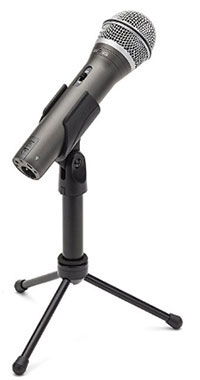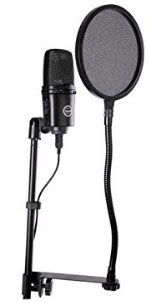
Here is my review of the Samson Q2U microphone. They call this, more specifically, the “Q2U Recording and Podcasting Pack.”
If you don’t want the gory details, I’ll tell you the results of the review right here. The Q2U is excellent! It’s better than the Q1U by a lot and it is almost as good as the Shure SM58 dynamic mic, which costs a lot more.
If you do want to know a bit more…
What is it?
The Q2U is a USB/XLR dynamic microphone. See our post Condenser vs Dynamic Microphones for more on what it means to be a dynamic mic. But what in the world is a “USB/XLR” mic?
Most folks are familiar with what USB microphones are. They are pretty amazing. You don’t need an external interface to plug it into your computer. You just plug the microphone’s USB cable straight into the computer. The sound quality is leaps and bounds better than the traditional direct-to-computer mics that came before. You know, the kind with the little 1/8th inch pin that you stick into your computer’s sound card?
But what about “XLR?”
Standard microphones are typically much higher quality than any direct-to-computer mics. But you need extra gear to get them to connect to your computer. At a minimum, you need:
- A premplifier – microphones need amplification to be made audible
- An analog-to-digital converter – microphones capture “regular audio” (sound waves in the air) and preamps make that louder louder. But that captured sound needs to be converted to “computer language” before you can do anything with it. That is what a converter does. See our post What is An AD Converter? for more on that.

Fortunately, these days most “interface” units (such as the Focusrite Scarlett and at least a dozen similar products) contain both the preamp and converters in a single unit. They are amazingly affordable in 2017. For instance, the Focusrite Scarlett Solo is only about $100.
The XLR mic/interface box combo is basically the same setup used in high-end commercial recording studios. So if you can afford to jump on that train when starting out, I recommend that. The minimum investment there would be in the $175-$200 range.
If your budget isn’t quite there yet though, I usually recommend starting with a USB mic. You can get fantastic value for money that way. The mic I have been recommending as the lowest end still capable of professional sound has been the Samson Q1U mic for $49. But based on the tests I did for this review, I’m changing that to the newer Samson Q2U.
So Spill The Beans Already!
OK, to the results of the review. The short answer is – the Samson Q2U is better than the Q1U by a lot!
I suppose you want some details, right? Here they are.
- The Q2U is only $59 ($54.99 on with Amazon Prime), which is only $10 more than the Q1U.
- With the Q2U, Samson have somehow managed to all but eliminate the steady hiss that is so common in USB mics. This is huge! You can listen below to the difference in the “self-noise” (hiss) of both mics.
- Overall the sound quality is much better
- And it can be used as EITHER a USB mic or an XLR mic!
The Review
I compared the Q2U with both the Q1U AND the most common standard (XLR) dynamic mic in the world, the Shure SM58.
P-Pops
I did not use a pop filter or windscreen for the tests, because I wanted to find out how sensitive to p-pops these mics were without them.
Both the Q1U and the Q2U are extremely sensitive to p-pops. The Shure SM58 was MUCH less sensitive to those.
Noise
As I mentioned, the Q1U has quite a noticeable steady background hiss. You can filter this out with noise reduction, which I did. But that often affects the remaining audio somewhat, making it sound a bit muffled sometimes.
The Q2U (in USB mode) had much MUCH less background hiss than the Q1U. Clearly Samson made this a priority when designing this upgrade.
The Q2U (in XLR mode) had even less of the steady background hiss than when in USB mode.
The Shure SM58 had just about the same noise/hiss level as the Q2U in XLR mode. Did I mention yet that the SM58 is $99? That’s quite a bit more than the $59 for the Q2U, if you’re into math and stuff.
Sound Quality
This is always a bit subjective. But my assessment is that the sound quality of the Q2U was on a par with that of the SM58. The Q1U is not as good as either.
The Q2U also sounded better in XLR mode. But keep in mind, you would need to have an interface unit to use XLR mode – somewhere to plug in the 3-pin cable and provide pre-amplification and conversion. So that does add to the cost.
But even in USB mode, the improvement over the Q1U is significant.

The main difference between the Q2U and the SM58 was the sensitivity to p-pops, the bane of vocal recording. For the most part, you CAN edit p-pops out (see our post How to Fix a “P-Pop” in Your Audio With Sound Editing Software for how to do that). But that takes quite a long time, and it isn’t always 100% effective. So you will DEFINITELY want to record with either the included wind screen (the little foam “hat” that covers the screen) or a pop-filter such as the Auray Pop Filter (see pic on right).
The Audio Samples
Below are all the audio recordings I made for this review.
Note how sensitive both Samson are to P-Pops.
Next are those same recordings with the noise and p-pops edited out. I found that it was difficult in both Samson mics to really get rid of the p-pops once they were recorded. So you will definitely want to prevent these via some sort of pop screen or filter.
Just The Noise
I thought it would be very instructive to hear JUST the noise/hiss from the Q1U versus the Q2U. Be sure to listen in headphones to REALLY hear what’s going on. Here are those samples:
Conclusion?
Buy the Samson Q2U if your are looking for your first mic, your budget is limited, or you only really need a mic for the occasional audio recording application. I believe the Q2U has the biggest bang-for-the-buck of any microphone I’ve reviewed or used! It’s perfect for voice over applications, podcasts, video narration and singing.
I don’t think it’s as quite good as even the Shure SM58. But it’s pretty darned close. And you’d need extra gear (an interface) to make that work. So again – bang-for-the-buck! The Q2U is an excellent mic – much better than the Q1U.
To get yours, check it out here on Amazon.